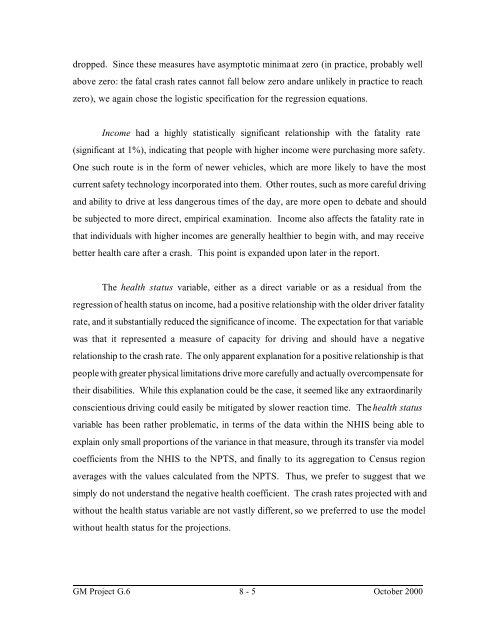Projecting Fatalities in Crashes Involving Older Drivers, 2000-2025
Projecting Fatalities in Crashes Involving Older Drivers, 2000-2025
Projecting Fatalities in Crashes Involving Older Drivers, 2000-2025
Create successful ePaper yourself
Turn your PDF publications into a flip-book with our unique Google optimized e-Paper software.
dropped. S<strong>in</strong>ce these measures have asymptotic m<strong>in</strong>ima at zero (<strong>in</strong> practice, probably well<br />
above zero: the fatal crash rates cannot fall below zero and are unlikely <strong>in</strong> practice to reach<br />
zero), we aga<strong>in</strong> chose the logistic specification for the regression equations.<br />
Income had a highly statistically significant relationship with the fatality rate<br />
(significant at 1%), <strong>in</strong>dicat<strong>in</strong>g that people with higher <strong>in</strong>come were purchas<strong>in</strong>g more safety.<br />
One such route is <strong>in</strong> the form of newer vehicles, which are more likely to have the most<br />
current safety technology <strong>in</strong>corporated <strong>in</strong>to them. Other routes, such as more careful driv<strong>in</strong>g<br />
and ability to drive at less dangerous times of the day, are more open to debate and should<br />
be subjected to more direct, empirical exam<strong>in</strong>ation. Income also affects the fatality rate <strong>in</strong><br />
that <strong>in</strong>dividuals with higher <strong>in</strong>comes are generally healthier to beg<strong>in</strong> with, and may receive<br />
better health care after a crash. This po<strong>in</strong>t is expanded upon later <strong>in</strong> the report.<br />
The health status variable, either as a direct variable or as a residual from the<br />
regression of health status on <strong>in</strong>come, had a positive relationship with the older driver fatality<br />
rate, and it substantially reduced the significance of <strong>in</strong>come. The expectation for that variable<br />
was that it represented a measure of capacity for driv<strong>in</strong>g and should have a negative<br />
relationship to the crash rate. The only apparent explanation for a positive relationship is that<br />
people with greater physical limitations drive more carefully and actually overcompensate for<br />
their disabilities. While this explanation could be the case, it seemed like any extraord<strong>in</strong>arily<br />
conscientious driv<strong>in</strong>g could easily be mitigated by slower reaction time. The health status<br />
variable has been rather problematic, <strong>in</strong> terms of the data with<strong>in</strong> the NHIS be<strong>in</strong>g able to<br />
expla<strong>in</strong> only small proportions of the variance <strong>in</strong> that measure, through its transfer via model<br />
coefficients from the NHIS to the NPTS, and f<strong>in</strong>ally to its aggregation to Census region<br />
averages with the values calculated from the NPTS. Thus, we prefer to suggest that we<br />
simply do not understand the negative health coefficient. The crash rates projected with and<br />
without the health status variable are not vastly different, so we preferred to use the model<br />
without health status for the projections.<br />
GM Project G.6 8 - 5<br />
October <strong>2000</strong>
















